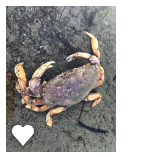U.S. Highway-101 beaches in Oregon
- Vesna
- Sep 26, 2021
- 4 min read
Updated: Nov 28, 2021


During my summer vacation, I went on a road trip through the U.S. highway-101 beaches. I visited some of the beaches in Newport, Lincoln City, Depoe Bay, and Cannon Beach, in Oregon. In all these beaches, I have found similar things including, but not limited to, Dungeness crabs, shells, clams, and many different kinds of jellyfish.
Although I couldn't find live animals in their real habitat (the water was too cold), many dead animals and plants did wash up on shore. For example, I saw many types of jellyfish in all the beaches we visited. One type was the water jelly and it usually appears as a flat, clear, blob with distinct radial canals. We saw most of these in Oregon (which was where we were most of the time, but they live all over the Pacific Coast. Another type we saw was the West Coast Sea Nettle and they are usually tan with reddish and yellowish hues. Their sting is mildly harmful, but most of the time, they prefer to avoid humans.
Like most animals, jellyfish prefer to stay away from humans, but they will sting if provoked. The venom is in the jellyfish tentacles, but you can get stung when you touch a jellyfish -- even a dead one. Most jellyfish stings don't result in emergencies, but it is good to know what to do. If you want more information on how to treat a sting visit the 3rd link in the reference section at the bottom of the page.
Did you know? In many cultures, people do eat jellyfish, as it is believed to be associated with many health benefits such as treating high blood pressure, arthritis, bone pain, ulcers, and digestive issues (DISCLAIMER: these claims have not been supported by research.) Although jellyfish does have many nutrients and health benefits, many retailers do not properly clean and preserve the delicacy, and it is said to contain high levels of aluminum. This can cause severe allergies and even death.
Newport:
Have you heard of the Yaquina Head Lighthouse (earlier known as Cape Foulweather Lighthouse) at Nye Beach? It's built on a bluff near the Yaquina river which flows into the Pacific Ocean. For just a day pass of $7, you can climb up a little more than 900 stairs, look through a working Fresnel lens, explore a tide pool, and watch as thousands of seabirds gather in one of the biggest colonies on the West Coast. It's been active since 1873 and although it was closed for awhile in the 1900s, it is now open to the public.
Another thing I saw at Nye Beach are barnacle covered rocks and sea anemone, as well as many water beetles and crabs. These rocks are normally concealed by the high tide, which was rushing in when I saw them; however, at low tide, there are probably many more things to explore. I also found many shells, sea dollars, and plants from the bottom of the ocean. There were even many types of birds, the most commonly seen being the Western Gull.
Depoe Bay:

Although Depoe Bay is famous for being the "world's smallest harbor", it is also famous for its "resident" gray whale population. Gray whales move up and down the west coast to Alaska and the months between May and October are prime time for finding many different types of sea life migrating. You won't be able to find whales while you're on the shore, so there are two things you can do. You can take a whale watching boat out to sea where they point out whales right next to you, or you can a couple stairs, get elevated, and watch the waves to find animals. We say many whale fins, tails, and other body parts, and we even saw a couple whales jumping out of the water.
Cannon Beach:

At Cannon Beach, we saw natural tidal pools that were created by the ocean. A tidal pool is created when the water recedes at low tide. In a tidal pool, you can find many animals such as starfish, sea anemones, barnacles, crabs, seashells, and a limited amount of fish that got caught. There were many local fisherman and beach enthusiasts combing the seashore for tidal creatures. In one of the deeper tidal pools we saw multiple live Dungeness crabs that got caught. We also found a small fish that got stuck. It was breathing, but looked very unhealthy. I tried moving it to a deeper section of water, but it was too late. Many people try catching these animals to take home, but it's actually illegal to do so in many countries. Of course, taking crabs are fine, but taking starfish or other rare/endangered animals is not ok.
In addition to tidal pools, we also saw Haystack Rock, which is one of Oregon's most recognizable places. It was formed by lava flows and basalt rocks, about 235 feet from the edge of the shoreline. It is home to many animals such as sea stars, anemone, crabs and chitons. Many bird watchers also come to this renowned place, as it is home to many different species of birds including the Black Oystercatcher, Harlequin Ducks, Bald Eagles, Peregrine Falcons, Pigeon Guillemot, Western Gull, Pelagic Cormorant, and the most commonly seen, the Tufted Puffin.
Did you know about the Haystack Rock Awareness Program? It was developed in the 1980s to protect the ecosystem and provide information for visitors. They set up microscopes and telescopes for public use, and also provide programs to help encourage interest in this interesting and delicate ecosystem.
I had a great time at the beach (as you can tell), and I hope that you can visit soon as well.
Reference:
https://seagrant.oregonstate.edu/visitor-center/found-beach/velella-velella
https://www.healthline.com/nutrition/can-you-eat-jellyfish#benefits
https://kidshealth.org/en/parents/jellyfish.html
https://www.orcanetwork.org/Main/index.php?categories_file=Gray%20Whales


















Comments